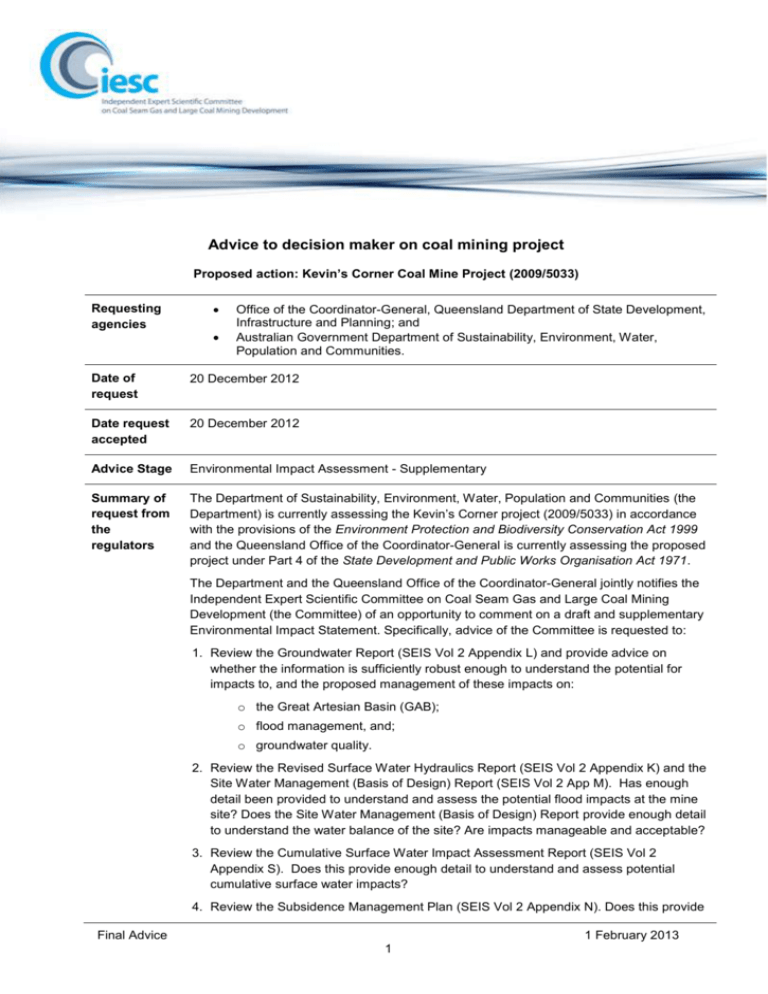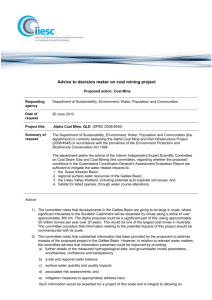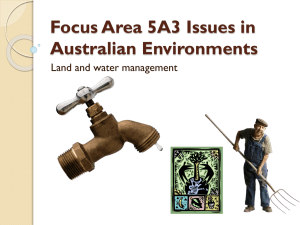Kevin`s Corner Coal Mine Project Advice (DOCX
advertisement

Advi Advice to decision maker on coal mining project Proposed action: Kevin’s Corner Coal Mine Project (2009/5033) Requesting agencies Office of the Coordinator-General, Queensland Department of State Development, Infrastructure and Planning; and Australian Government Department of Sustainability, Environment, Water, Population and Communities. Date of request 20 December 2012 Date request accepted 20 December 2012 Advice Stage Environmental Impact Assessment - Supplementary Summary of request from the regulators The Department of Sustainability, Environment, Water, Population and Communities (the Department) is currently assessing the Kevin’s Corner project (2009/5033) in accordance with the provisions of the Environment Protection and Biodiversity Conservation Act 1999 and the Queensland Office of the Coordinator-General is currently assessing the proposed project under Part 4 of the State Development and Public Works Organisation Act 1971. The Department and the Queensland Office of the Coordinator-General jointly notifies the Independent Expert Scientific Committee on Coal Seam Gas and Large Coal Mining Development (the Committee) of an opportunity to comment on a draft and supplementary Environmental Impact Statement. Specifically, advice of the Committee is requested to: 1. Review the Groundwater Report (SEIS Vol 2 Appendix L) and provide advice on whether the information is sufficiently robust enough to understand the potential for impacts to, and the proposed management of these impacts on: o the Great Artesian Basin (GAB); o flood management, and; o groundwater quality. 2. Review the Revised Surface Water Hydraulics Report (SEIS Vol 2 Appendix K) and the Site Water Management (Basis of Design) Report (SEIS Vol 2 App M). Has enough detail been provided to understand and assess the potential flood impacts at the mine site? Does the Site Water Management (Basis of Design) Report provide enough detail to understand the water balance of the site? Are impacts manageable and acceptable? 3. Review the Cumulative Surface Water Impact Assessment Report (SEIS Vol 2 Appendix S). Does this provide enough detail to understand and assess potential cumulative surface water impacts? 4. Review the Subsidence Management Plan (SEIS Vol 2 Appendix N). Does this provide Final Advice 1 February 2013 1 enough detail to understand and assess the impacts of subsidence? Are impacts manageable and acceptable? 5. Review section T.3.4 (Water Resources) of the Environmental Management Plan (SEIS Vol 2 Appendix T1). Will the proposed mitigation and control strategies mitigate potential impacts of the project to water resources? Advice The Committee was referred the Kevin’s Corner proposal, in the Queensland Burdekin catchment, for joint advice at the supplementary environmental impact statement stage to the Commonwealth and State regulators. Regional Consideration 1. In terms of cumulative impacts within the Galilee Basin, the Committee notes that the Interim Independent Expert Scientific Committee considered the Alpha Coal Project in 2012 and that a suite of further projects is proposed for the region. It is anticipated that the developments in the Galilee Basin are going to be large in scale, with tributaries to the Burdekin Catchment dissected by mines along a coal strike of approximately 300 km. The Kevin’s Corner proposal may significantly contribute to cumulative impacts associated with mining proposals along this strike, noting that the project will be one of the largest coal mines in Australia, mining approximately 30 million tonnes of coal per year for over 30 years. Further, more than three billion tons of overburden and interburden will be generated from the open-cut pits. As such, the Committee considers that information relating to the potential impacts of this project should be commensurate with its scale. 2. Given the pending development scenarios for the region, the Committee has been advised by the Office of Water Science that the Galilee Basin has been identified as a priority sub-region for completion of a bioregional assessment. The Committee recommends that the bioregional assessment should include an assessment of groundwater impacts associated with the Galilee Basin (which may affect the Great Artesian Basin to the west), and surface water impacts associated with the Burdekin Catchment (which may be impacted to the east). Kevin’s Corner 3. The Committee suggests that a regional and site water balance should be provided as baseline information and a risk-based approach should be developed to examine local and regional impacts. The cumulative impact assessment should also include an assessment of habitat loss and impacts to ecological systems. 4. In terms of the integrity of the Rewan Formation (the basal confining unit of the hydrological Great Artesian Basin), particularly in relation to its ability to restrict connectivity with the Great Artesian Basin, the Committee advises that the Formation is generally considered to have low porosity and permeability. However, there is evidence to suggest that localised faulting may exist. Thus, while the primary porosity and permeability of the rock matrix is considered to be low, it is plausible that site specific faulting presents a potential for connectivity and vertical groundwater flow. The extent of faulting in the Rewan Formation in the local setting should be determined in order to inform the connectivity assessment. The Committee further notes that there are a range of studies underway, such as the Great Artesian Basin Water Resource Assessment, which will provide for better understanding of the level of complexity and connectivity in such systems. 5. The Committee considers that groundwater quality may be impacted by increased aquifer connectivity associated with subsidence and from uncertainty regarding tailings management. The Committee notes that toxicants (associated with overburden placed into out-of-pit emplacement areas for the first two years of mining) are predicted to remain on site, migrating towards the Kevin’s Corner and Alpha final voids. However, a detailed tailings assessment is required to determine potential impacts from the Final Advice 1 February 2013 2 overburden that will be placed in-pit behind the active mining strip. 6. In terms of impacts to surface water, the Committee considers that the proposed discharge scenarios are inadequate, as scenarios are not discussed for all of the proposed release points. Further, water quantity and quality parameters of proposed medium and high flow discharge scenarios appear to be significantly above, site specific, reference data and have the potential to adversely impact ecological communities. 7. The Committee considers that the proponent’s existing discharge strategy is inadequate. The strategy should be revised so that median levels for water quality parameters for stressors should not exceed the relevant 80th percentile values of reference data for the appropriate discharge. The median release water quality for toxicants should be sufficient to protect 95 per cent of species, consistent with ANZECC 2000 guidelines. If water quality parameters are unable to be met water should be retained on site, such as in proposed dams or temporarily stored in open-cut pits, and treated to levels that allow discharge with no or minimal environmental risks. Baseline monitoring should also be undertaken daily after an event, for a minimum of the first seven days, to help determine water quality parameters of first flush events. 8. The Committee notes that the Kevin’s Corner and Alpha projects involve a number of creek diversions and levees which have the potential to impact water quality and local hydrology. Specifically: a. the Alpha Project will divert creeks towards the Kevin’s Corner tenement. Due to the close proximity of the creeks to the Kevin’s Corner mine, the Committee considers that there may be ingress of surface water to completed longwall panels; and b. in sections where stream power is increasing, the Kevin’s Corner creek diversion has the potential to increase erosion in some areas (especially in areas affected by subsidence), which may reduce channel capacity and increase floodplain inundation and frequency. Changes to hydrology have the potential to alter community composition towards species which can tolerate more frequent inundation. 9. The Committee considers that subsidence also has the potential to alter surface-groundwater connectivity. It is highly probable that fracturing will have surface expression over a significant portion of the proposed mine resulting in increased surface water loss to the groundwater. It is stated by the proponent that clays present in the overburden will swell to stop this leakage; however no supporting evidence has been provided to support this claim. Subsidence and associated mitigation measures are also likely to alter water quantity and quality and vegetation communities towards species which can tolerate more frequent inundation. Further, the Committee notes that there is insufficient evidence to substantiate the effectiveness of proposed mitigation measures at the site. 10. The Committee also considers that changes to hydrology may impact vegetation community composition at the site. For example, inundation regimes may adversely impact Matters of National Environment Significance (e.g. Black Throated Finch and Red Goshawk) in the area. Due to the reduction in catchment area from the Alpha and Kevin’s Corner proposals, the proponent’s assessment concludes that areas inundated for more than 96 hours will be reduced. The Committee considers that further information is required to determine potential impacts from the proposal, such as site species tolerances to inundation regimes and implications for Matters of National Environmental Significance. 11. The Committee notes that the proponent proposes a number of conditions as part of the Environmental Management Plan, italicised below, and suggests the following points: a. Proposed condition W15: The environmental authority holder must notify the administering authority as soon as practicable, and no later than 24 hours, after commencing to release mine affected water to the receiving environment. Notification must include the submission of written advice to the administering authority of the following information: i. release commencement date/time; Final Advice 1 February 2013 3 ii. expected release cessation date/time; iii. release point/s; iv. release volume (estimated); v. receiving water/s including the natural flow rate; and vi. details (including available data) regarding likely impacts on the receiving water/s. To assist in determining potential impacts, the Committee suggests the addition of information relating to: expected release timings and durations; released water quality; water quality upstream and downstream of release sites; and the total estimated salt loads and heavy metal concentrations of the discharge event. b. Proposed condition W22: If quality characteristics of the receiving water at the downstream monitoring points exceed any of the specified trigger levels during a release event, the Environmental Authority holder must compare the downstream results to the upstream results in the receiving waters and: i. where the downstream result is the same or a lower value than the upstream value for the quality characteristic then no action is to be taken; or ii. where the downstream results exceed the upstream results, complete an investigation in accordance with the ANZECC and ARMCANZ 2000 methodology, into the potential for environmental harm and provide a written report to the administering authority in the next annual return outlining: 1. details of the investigation carried out; and 2. actions to prevent environmental harm. The Committee suggests for Condition W22 (and where relevant for W15) that disposal of pit water should be underpinned by best environmental practice and take into consideration the frequency of extreme weather conditions/events. c. Proposed condition W60: The holder of the environmental authority must monitor and record water levels within the Rewan Formation as the basal aquitard unit of the Great Artesian Basin ... Where groundwater drawdown fluctuations of five metres or more below the minimum levels recorded within the Rewan Formation during background monitoring ... are recorded, not resulting from pumping of licensed bores, the holder of this environmental authority must undertake an assessment of the potential for induced flow from the Great Artesian Basin aquifers. The holder must notify the administrating authority of the outcomes of this assessment within 14 days following completion of this assessment. The Committee notes that the proposed five metre drawdown trigger conforms with the Queensland Baseline Assessment Guideline (2011) definition of long term affected areas. However, as information on observed water levels and fluctuations does not appear to have been provided, the Committee is unable to determine whether a five metre drawdown trigger in the Rewan Formation is adequate for early detection of induced flow from Great Artesian Basin aquifers. The Committee suggests that consideration be given to an independent assessment to determine an appropriate drawdown trigger level for the Rewan Formation. The assessment should be in addition to proposed monitoring of the Clematis Sandstone and the development of a cumulative impacts model for the Galilee Basin. Date of advice 1 February 2013 Final Advice 1 February 2013 4





